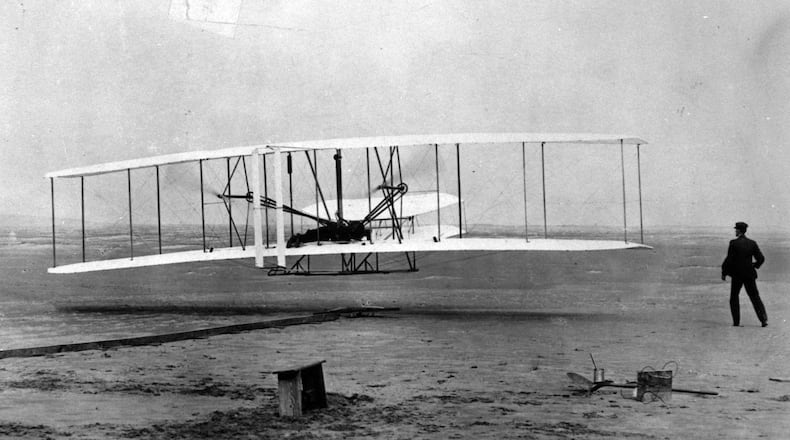Apparently, not so well.
The Dayton Evening Herald painted a vivid picture of the Wright brothers’ first flight.
“DAYTON BOYS FLY AIRSHIP” read the front page headline in the Dec. 18, 1903 edition of the newspaper.
“Wilber and Orville Wright, of Dayton, O., have solved the problem of aerial navigation by successfully flying their airship, with which they have been experimenting for the past three years,” began the account, which misspelled Wilbur’s name.
“The flight began from a platform constructed upon a high hill near Kitty Hawk. There was no starting apparatus used to give momentum to the huge bird-like affair.”
Though descriptive, the story was filled with inaccuracies.
The report stated the flight had been three miles long, and it also redesigned the airplane, adding extra equipment that included a “six-bladed ‘underwheel’ that pushed the machine up into the air,” according to “The Bishop’s Boys” written by Tom Crouch.
Orville Wright later described the article as “99 percent wrong,” according to a 1970 story written by Roz Young of the Dayton Journal Herald.
The story was written by a trio of men working for The Norfolk Virginian-Pilot. Unable to get in touch with the Wrights or anyone who had seen the flight, the men sat down at a typewriter anyway and tried to piece the story together.
While the Evening Herald ran that embellished version of the story, an early edition of the Dayton Daily News published just the barest of facts.
Under a headline, “THE WRIGHT BOYS ARE COMING HOME” an underwhelming brief with a Norfolk, Va. dateline was published in the Dec. 19 edition.
“Orville and Wilbur Wright, inventors of the “Wright Flyer,” which made several successful flights near here Thursday, left today for their home in Dayton, O., to spend Christmas with their parents.”
The Dayton Journal missed the boat completely.
Lorin Wright, on instruction from his brothers, headed down to the newspaper offices to deliver the news.
According to “The Bishop’s Boys,” the Associated Press representative that Lorin encountered, Frank Tunison, turned him away because he didn’t find the flights newsworthy.
In the following days, the full reality of the triumph became clearer, and Dayton’s newspapers played journalistic catch-up with more extensive and accurate explanations.
Two days before Christmas, the Dayton Evening Herald redeemed itself by publishing an interview with the aviation pioneers.
Wilbur talked about their plans to continue work in Kitty Hawk in the spring and that “some experts of the government have become interested.”
Orville’s statement to the reporter summed up their accomplishment.
“Gravitation and ourselves have had a hard tussle and I am glad we won out,” he said. “I think it now a matter of a very short while when transit through the air will be a thing of small moment.”



